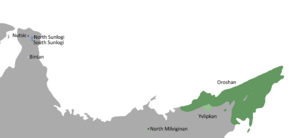Gujino-Bintani languages: Difference between revisions
(added map, and fixed some mistakes. revised number of speakers down, and added numbers of speakers in list) |
m (caption was wrong) |
||
| Line 10: | Line 10: | ||
| child2 = Bintani languages | | child2 = Bintani languages | ||
| map = Gblmap.png | | map = Gblmap.png | ||
| mapcaption = Geographic distribution of Gujin languages ( | | mapcaption = Geographic distribution of Gujin languages (greens) and Bintani languages (blues) in 2010. | ||
}} | }} | ||
Latest revision as of 12:23, 19 April 2022
This article is incomplete because it is pending further input from participants, or it is a work-in-progress by one author. Please comment on this article's talk page to share your input, comments and questions. Note: To contribute to this article, you may need to seek help from the author(s) of this page. |
| Gujino-Bintani | |
|---|---|
| Geographic distribution | Northern and northeastern Surucia |
| Linguistic classification | One of the world's primary language families |
| Proto-language | Proto-Gujino-Bintani |
| Subdivisions |
|
 Geographic distribution of Gujin languages (greens) and Bintani languages (blues) in 2010. | |
The Gujino-Bintani languages are a language family of northern and northeastern Surucia. Traditionally the languages of nomadic reindeer herders, most of the family is endangered, though one language, Oroshan, is the official language in Oroshia. In 2018, there were an estimated 2,320,000 speakers of Gujino-Bintani languages, most of which are speakers of Oroshan. Various connections to other language families have been made, most famously Namchog and Jogin, both of which were discredited by the combined efforts of Baptistois linguist Théodore Lozé, and Tyrnican linguist Friedrich Haas. Lozé and Haas reconstructed a Proto-Gujino-Bintani language in the early 1980s.
Classification
The family is divided into two major groupings: the Gujin languages and the Bintani languages. The validity of the Bintani group has since been questioned by several scholars, and may better represent an areal grouping than a genetic one. All Gujino-Bintani languages are under pressure from other languages, except Oroshan. Gujin languages, given their higher number of speakers, are better attested.
- Gujin
- Bintani
- Core Bintani
- Bintan (~2500 speakers)
- Peripheral Bintani
- Nutsic1 (~2000 speakers)
- North Sunlogi (~5000 speakers)
- South Sunlogi (<100 speakers)
- East Sunlogi †
- Core Bintani
1Nutsic may form a dialect continuum with North Sunlogi, without the inclusion of South Sunlogi.
Proto-language
The phonology of Proto-Gujino Bintani was reconstructed in 1981.
| Labial | Alveolar | Palatal | Velar | Uvular | Glottal | |
|---|---|---|---|---|---|---|
| Nasal | m | n | ||||
| Plosive | p | t | k | q | ʔ | |
| Fricative | s | |||||
| Approximant | w | ɹ | j |
| Front | Central | Back | |
|---|---|---|---|
| Close | i | u | |
| Open | a |
Proto-Gujino-Bintani probably considered /ʔ/ a full phoneme, and had it productive in affixes, giving rise to the glottalization characteristic of the Gujin languages. Bintan seems to have preserved some form of this original affix. Stress was likely variable, and led to the weakened vowel patterns in Gujin languages before stress shifted word-finally in that group. Given that all extant members of the family are agglutinative and head-final, it was assumed that Proto-Gujino-Bintani would have been, too. Despite Peripheral Bintani languages having a nominative-accusative alignment, Proto-Gujino-Bintani was likely ergative-absolutive, as are the rest of its proposed descendants.
Following Lozé's work comparing Yvlipkan and Oroshan, the sample of comparative vocabulary was expanded in 1982 with Haas to cover many languages in the family.
| Proto-Gujino-Bintani | Bintan | Nutsic | North Milviginan | Yvlipkan | Oroshan | Meaning |
|---|---|---|---|---|---|---|
| *mir | mir | mer | mjas | mis | mił | sun |
| *quka | quka | quk | quk | ğoğ | quğ | ice |
| *anakatis | nakatis | anakač | aŋkač | ŋgač | aŋkač | strong |
| *sikaw | sikaw | sikaw | sjakav | ŧigaw | sikav | berry |
| *katis(-ajir) | katis | kač | kačajis | kədžajs | kačajł | two |